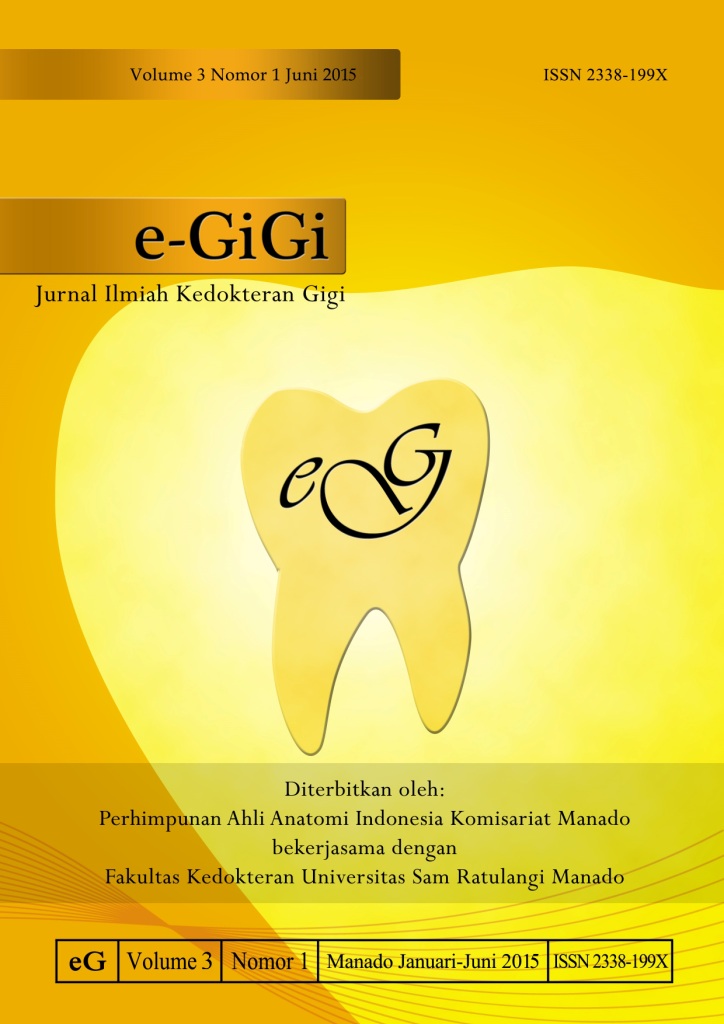GAMBARAN RONGGA MULUT PADA LANSIA PEMAKAI GIGI TIRUAN SEBAGIAN LEPASAN DI PANTI WERDA KABUPATEN
DOI:
https://doi.org/10.35790/eg.3.1.2015.6562Abstract
Abstract: Removable partial dentures can be an alternative treatment for tooth loss in the elderly. Users of removable partial dentures without good treatment can cause a variety of changes to the conditions of hard tissue and soft tissues of the oral cavity which is the first driveway for human digestive system. In addition, the use of removable partial dentures in the elderly are particularly susceptible to the occurrence of disorders of the oral cavity. The purpose of this study is to provide a picture of the oral cavity in elderly users of removable partial dentures in elderly nursing home in Minahasa. This is a descriptive cross sectional study. This study used a total sampling method, with respondents is a 30 elderly users of removable partial dentures in elderly nursing home in Minahasa. The results showed that the presence of ulcers as a result of artificial teeth in the upper jaw 66.67%, ulcers due to artificial teeth on the lower jaw 50%, 30% gingival redness, swelling of the gingiva 30%, 36.67% gingival bleeding, gingival recession at 46, 67%, 50% Denture stomatitis, angular celulitis 46.67%, Plaque 43.33%, 56.66% calculus, caries 93.33%. The research shows elderly users of removable partial dentures in elderly nursing home in Minahasa have a conditions change for hard and soft tissues of the oral cavity. Suggested the elderly to pay more attention to health and hygiene denture for more vigorous control the state of the denture and the state of the oral cavity in dentistry.
Keywords: oral cavity condition, elderly, dental removable partial dentures
Abstrak: Gigi tiruan sebagian lepasan dapat menjadi salah satu alternatif perawatan terhadap kehilangan gigi pada lansia. Pengguna gigi tiruan sebagian lepasan tanpa perawatan yang baik dapat menyebabkan berbagai perubahan terhadap kondisi jaringan keras dan jaringan lunak pada rongga mulut yang merupakan jalan masuk pertama sistem pencernaan manusia. Disamping itu, pemakaian gigi tiruan sebagian lepasan pada lansia sangat rentan terhadap kejadian kelainan – kelainan pada rongga mulut. Tujuan dari penelitian ini yaitu untuk memberikan gambaran keadaan rongga mulut pada lansia pemakai gigi tiruan sebagian lepasan di panti werda Kabupaten Minahasa. Penelitian ini merupakan penelitian deskriptif cross sectional. Penelitian ini menggunakan metode total sampling, dengan responden sebanyak 30 orang lansia pemakai gigi tiruan sebagian lepasan yang ada di panti werdha Kabupaten Minahasa. hasil penelitian menunjukan bahwa adanya Ulser akibat gigi tiruan pada rahang atas 66,67%, Ulser akibat gigi tiruan pada rahang bawah 50%, Kemerahan gingiva 30%, pembengkakan gingiva 30%, pendarahan pada gingiva 36,67%, Resesi pada gingiva 46,67%, Denture stomatitis 50%, angular celulitis 46,67%, Plak 43,33%, Kalkulus 56,66%, karies 93.33%, Kegoyangan 23,33%. Hasil penelitian menunjukan lansia pengguna gigi tiruan sebagian lepasan di panti werda Kabupaten Minahasa mengalami perubahan kondisi jaringan keras dan jaringan lunak pada rongga mulut. Disarankan para lansia untuk lebih memperhatikan kesehatan dan kebersihan gigi tiruan untuk lebih giat mengontrol keadaan gigi tiruan dan keadaan rongga mulut di dokter gigi.
Kata Kunci: kondisi rongga mulut, lansia, gigi tiruan sebagian lepasan
Downloads
Published
How to Cite
Issue
Section
License
COPYRIGHT
Authors who publish with this journal agree to the following terms:
Authors hold their copyright and grant this journal the privilege of first publication, with the work simultaneously licensed under a Creative Commons Attribution License that permits others to impart the work with an acknowledgment of the work's origin and initial publication by this journal.
Authors can enter into separate or additional contractual arrangements for the non-exclusive distribution of the journal's published version of the work (for example, post it to an institutional repository or publish it in a book), with an acknowledgment of its underlying publication in this journal.
Authors are permitted and encouraged to post their work online (for example, in institutional repositories or on their website) as it can lead to productive exchanges, as well as earlier and greater citation of the published work (See The Effect of Open Access).






